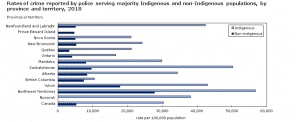Crime is more likely to be reported in remote communities, specifically with high Indigenous populations according to a recent survey. Although, Yellowknives Dene First Nation Chief Ernest Betsina says this isn’t a fair depiction of Indigenous communities.
“Our youth are not genetically prone to crime. It’s a symptom of social conditions,” says Chief Ernest Betsina for the Yellowknives Dene First Nation.
According to Statistics Canada, 182 police services reported some of the highest rates of crime compared to other detachments in Canada.
Those 182 police detachments were found to serve predominantly Indigenous peoples.
Police reported in 2018, that crime rates for these Indigenous communities were six times higher than in predominantly non-Indigenous populations.
Mary Allen, author of the report found that this was due to petty crimes such as mischief, common assault and disturbing the peace.
The highest crime rates in Indigenous communities were found in the Northwest Territories, Saskatchewan and Manitoba, the report claims.
“Enforcement is only short term, it only deals with the existing problem,” says Betsina.

According to Statistics Canada, the Northwest Territories has the highest reported crime-rate in predominantly Indigenous communities, in all of Canada. (Statistics Canada)
It goes deeper
The report is not a “fair representation of the communities.”
“The majority of crime is related to trauma, alcohol and drugs,” Betsina adds.
Many Indigenous residents have suffered a “sad legacy,” experiencing residential schools and many have “fallen through the cracks.”
With the effects of colonialism, residential schools, intergenerational trauma, and residents not having the tools and the power to address these things on their own, Betsina argues – this report proves that “our communities need help.”
“By comparing similar rural communities to each other rather than compared to larger heavily populated urban areas, it may give a more accurate picture for the North,” says Sue Glowach, spokesperson for the department of Justice.
“A community of 500 people would have a greater police presence than a community of 3500 due to the staffing minimums,” she says, contributes to the appearance of a heavier police presence in the communities.
“Everyone believes that enforcement is going to solve these issues,” Betsina says, adding that’s not the case. “We need more counselling services, rehabilitation facilities and infrastructure to combat the effects of crime on the communities.”
The report acknowledges that there are distinct causes such as intergenerational trauma, mental health and alcohol abuse that often contribute to higher crime rates in Indigenous communities.
Mariah Caruso is a digital journalist, originally from Toronto, Canada. She graduated from the University of Toronto with a Hons. Bachelor of Arts and completed her Journalism post-grad at Sheridan College. She has an insatiable appetite for life, storytelling, connecting to the people, and getting to the heart of the issue.
On her spare time, you can find her at your local coffee shop writing songs, poetry and prose or at the gym out-lifting men.
If you have a story idea, feel free to send her an email at mariah.caruso@cklbradio.com or call 867-766-2552 Ext 108






